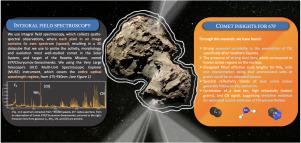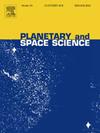67P/ Churyumov-Gerasimenko彗星最近的化学形态彗发演化
IF 1.7
4区 物理与天体物理
Q3 ASTRONOMY & ASTROPHYSICS
引用次数: 0
摘要
我们展示了彗星67P/Churyumov-Gerasimenko在2021年近日点通过期间的VLT/MUSE观测结果,从中我们同时生成了12个近日点前后的尘埃,[OI], C2, NH2和CN彗星的地图。这些地图揭示了67P彗发的演化和组成趋势,进一步丰富了ESA罗塞塔任务的背景和发现。尘埃和气体显示出不同的结构,其中NH2和CN信号与已知的尘埃扇独特地相关,这提出了与尘埃和扩展源的贡献可能相关的问题。局部拟合的NH2尺度长度比其余部分拟合的NH2尺度长度大1.5-1.9倍,这与北方近日点前发射的扩展源成分相一致。在南半球,CN与一个突出而尖锐的尘埃结构相关,可能通过较大的尘埃颗粒揭示了一个扩展的源起源,这些尘埃颗粒保存了CN的母种,正如该地区较高的光谱斜率所证明的那样。气体图描绘了两种不同的演化机制:(1)由核升华和亚太阳日照驱动的H2O ([OI]1D)和C2排放的演化;(2)与季节动态和可能的分布源相关的稳定的NH2和CN排放。尘埃光谱斜率图显示的光谱斜率趋势与罗塞塔号的发现一致,而绿色/红色[OI]比率通常表明以H2O为主的昏迷。本文章由计算机程序翻译,如有差异,请以英文原文为准。

Recent Chemo-morphological coma evolution of comet 67P/Churyumov–Gerasimenko
We present VLT/MUSE observations of comet 67P/Churyumov-Gerasimenko during its 2021 perihelion passage, from which we generated simultaneous maps of dust, [OI], C, NH, and CN comae across 12 pre- and post-perihelion epochs. These maps reveal the evolutionary and compositional trends of 67P’s coma and further enrich the context and findings of ESA’s Rosetta mission. Dust and gas species displayed distinct structures, where NH and CN signals were uniquely associated with known dust fans, raising the question of possible correlation to the dust and contributions of extended sources. Localised fitted NH scale lengths were 1.5-1.9 larger than those fitted for the rest of the coma, which is consistent with an extended source component for northern pre-perihelion emissions. In the southern hemisphere, CN was correlated with a prominent and sharp dust structure, potentially revealing an extended source origin via larger dust particles that preserve the CN parent species, as evidenced by higher spectral slopes in the region. Gas maps depicted two distinct evolutionary regimes: (1) evolving HO ([OI]1D) and C emissions driven by nucleus sublimation and subsolar insolation, and (2) stable NH and CN emissions associated with seasonal dynamics and possible distributed sources. Dust spectral slope maps revealed spectral slope trends consistent with Rosetta findings, while green/red [OI] ratios generally indicate a coma dominated by HO.
求助全文
通过发布文献求助,成功后即可免费获取论文全文。
去求助
来源期刊

Planetary and Space Science
地学天文-天文与天体物理
CiteScore
5.40
自引率
4.20%
发文量
126
审稿时长
15 weeks
期刊介绍:
Planetary and Space Science publishes original articles as well as short communications (letters). Ground-based and space-borne instrumentation and laboratory simulation of solar system processes are included. The following fields of planetary and solar system research are covered:
• Celestial mechanics, including dynamical evolution of the solar system, gravitational captures and resonances, relativistic effects, tracking and dynamics
• Cosmochemistry and origin, including all aspects of the formation and initial physical and chemical evolution of the solar system
• Terrestrial planets and satellites, including the physics of the interiors, geology and morphology of the surfaces, tectonics, mineralogy and dating
• Outer planets and satellites, including formation and evolution, remote sensing at all wavelengths and in situ measurements
• Planetary atmospheres, including formation and evolution, circulation and meteorology, boundary layers, remote sensing and laboratory simulation
• Planetary magnetospheres and ionospheres, including origin of magnetic fields, magnetospheric plasma and radiation belts, and their interaction with the sun, the solar wind and satellites
• Small bodies, dust and rings, including asteroids, comets and zodiacal light and their interaction with the solar radiation and the solar wind
• Exobiology, including origin of life, detection of planetary ecosystems and pre-biological phenomena in the solar system and laboratory simulations
• Extrasolar systems, including the detection and/or the detectability of exoplanets and planetary systems, their formation and evolution, the physical and chemical properties of the exoplanets
• History of planetary and space research
 求助内容:
求助内容: 应助结果提醒方式:
应助结果提醒方式:


